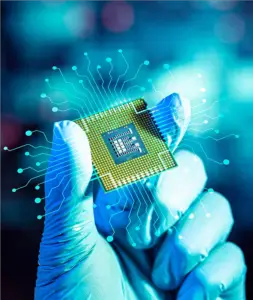
Why semiconductor fabrication plant in news?
- The Union Cabinet has given the green light to three significant chip-related initiatives, marking a pivotal moment in India’s technological advancement.
- Among these projects is the groundbreaking approval for the country’s inaugural semiconductor fabrication plant. This decision underscores India’s commitment to fostering indigenous innovation and strengthening its position in the global technology landscape.
- With this milestone, India is poised to become a key player in semiconductor manufacturing, opening up new avenues for economic growth and technological leadership.
India Approves Tata Group’s Semiconductor Projects
- Semiconductor Plant in Dholera, Gujarat:
- Collaboration between Tata Group and Powerchip Semiconductor Manufacturing Corp (PSMC).
- Offers access to advanced technology nodes: 28 nm, 40 nm, 55 nm, 90 nm, and 110 nm.Monthly capacity of 50,000 wafers.
- Chip Assembly Plant in Morigaon, Assam:
- Tata Group to establish a chip assembly plant.
- Capacity to manufacture 48 million chips per day.
- Primarily caters to export requirements.
- Chip Packaging Facility in Sanand, Gujarat:
- Approval for a chip packaging facility in Sanand.
- Enhances India’s domestic semiconductor manufacturing capabilities.Strengthens India’s position in the global semiconductor industry.
Understanding Semiconductors: The Building Blocks of Modern Electronics
- Basics:
- Semiconductors, often referred to as ‘chips,’ consist of intricate electronic circuits comprising transistors, diodes, capacitors, resistors, and interconnections.
- These circuits are intricately arranged on a silicon wafer, enabling various electronic devices’ production, such as diodes, transistors, and integrated circuits.
- Industry Dynamics:
- Success in the industry hinges on creating smaller, faster, and cheaper products. Intense competition drives innovation, with new technologies driving down production costs per chip.
- Major players from countries like the United States, China, South Korea, and Taiwan dominate the market, but India is emerging as a significant contender.
- Key Terms Associated with its Industry:Wafers:
- Flat round disks of silicon on which chips are built.
- Fab: Facilities specialized in manufacturing, where miniature circuits are printed onto silicon wafers.Transistors: Tiny devices embedded in computer chips, with potential for billions on a single chip. Foundry: Manufacturing facilities producing integrated circuits based on external designs.
- India’s Technological Landscape and Market Opportunities:
- India’s consumption projected to reach $64 billion by 2026.
- Strong in R&D and design, with growing interest in fabrication and post-production assembly.
- Potential for high-tech clusters and special economic zones to support manufacturing.
- Government Initiatives and Policies:
- National Policy on Electronics (NPE) and Semicon India Program aim to bolster the manufacturing ecosystem.
- India Semiconductor Mission (ISM) focuses on fostering a sustainable industry through various schemes and incentives.
- Strategic Significance of Fabrication in Dholera:
- Reducing dependence on imports and balancing trade deficits.
- Boosting the manufacturing sector, creating job opportunities, and offering comparative advantage.
- Enhancing resilience in global supply chains and fostering spillover effects in India’s high-tech economy.
- Challenges in Boosting the Domestic Sector:
- Lack of fabrication units and resource-intensive chip production.
- Limited engagement from market players due to complex application processes and infrastructure requirements.
- Initiatives like incentive programs facing challenges in attracting chipmakers and manufacturers due to lacklustre engagement.
People also ask
Q1: What is a semiconductor fabrication plant?
Ans: A semiconductor fabrication plant, also known as a fab, is a facility where semiconductors, or chips, are manufactured on silicon wafers through a series of intricate processes.
Q2: Why is India’s semiconductor fabrication plant considered pioneering?
Ans: India’s semiconductor fabrication plant is considered pioneering because it marks the country’s entry into domestic semiconductor manufacturing on a large scale, aiming to reduce dependence on imports and bolster technological self-sufficiency.
Q3: Where are new semiconductor plants being established in India?
Answer: The Cabinet has approved three proposals for setting up semiconductor facilities in India, including two plants by the Tata Group in Gujarat and Assam, and one by the Murugappa Group-owned CG Power in Gujarat. IT minister Ashwini Vaishnaw announced that construction on all three units will commence within 100 days.
Q4. How does the semiconductor fabrication plant contribute to innovation?
Ans: The semiconductor fabrication plant facilitates innovation by providing a platform for research and development in semiconductor technology, encouraging collaboration between industry and academia, and enabling the production of cutting-edge electronic devices.
Q5. What role does the government play in supporting India’s semiconductor fabrication plant?
Ans: The government plays a crucial role in supporting India’s semiconductor fabrication plant through policy initiatives, financial incentives, infrastructure development, and fostering a conducive business environment for semiconductor manufacturing.
Your point of view caught my eye and was very interesting. Thanks. I have a question for you.
Your article helped me a lot, is there any more related content? Thanks! https://www.binance.com/ph/register?ref=B4EPR6J0
Your article helped me a lot, is there any more related content? Thanks!
Your article helped me a lot, is there any more related content? Thanks!